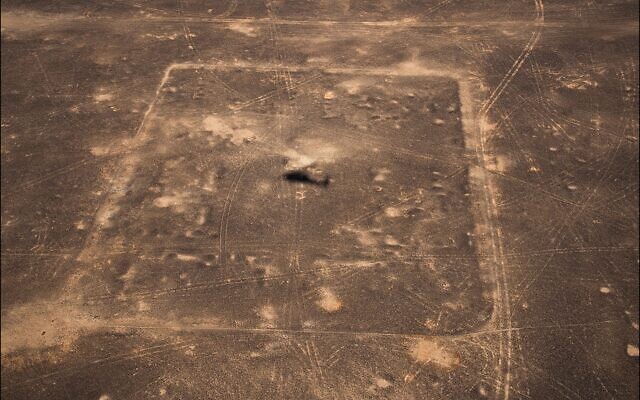Newly identified Roman army camps indicate unknown ancient campaign in Arabia
Google Earth imagery shows outlines of three sites in Jordan that have classic design of temporary bases built by Rome; believed tied to conquest of Nabatean kingdom
Stuart Winer is a breaking news editor at The Times of Israel.
Archaeologists have identified three sites that appear to have been temporary Roman military camps, stretched across a swath of territory in northern Arabia, that indicate a previously unknown campaign.
The discovery was made using remote image sensing, including photographs from Google Earth.
The research from the University of Oxford School of Archaeology, published in the journal Antiquity, said it was not currently possible to date the camps, which lie east of Bayir in Jordan, but speculated they were part of the 106 CE Roman annexation of the Nabatean kingdom, centered on the desert city Petra.
Michael Fradley, who led the research, told the BBC, “We are almost certain they were built by the Roman army.”
Though the study did not mention Masada, a mountainous site in southern Israel that the Romans were said to have besieged, there are remains of a Roman camp from around the same period located at the base of the mountain.
Researchers analyzed satellite imagery of southern Jordan from the Endangered Archaeology in the Middle East and North Africa (EAMENA) project, which uses images from Google Earth. They found a slight trace of a camp, and further study identified two additional sites to the east, with the furthermost near the border between modern-day Jordan and Saudi Arabia. The western and central camps were later photographed in November 2022 by the Aerial Archaeology in Jordan (AAJ) project.
The camps, researchers said, have the “classic playing-card shape of a Roman fort or camp.”
Images showed the symmetrical entrances that were typical of temporary camps built by the Roman army when it was on the march.
Our team's spectacular new discovery of #Roman military #camps in northern #Arabian desert using @googleearth has revealed an undocumented military #campaign across south east Jordan into Saudi Arabia.????????????????????????https://t.co/infxWZpBq4 pic.twitter.com/F8zqjIaQdD
— EAMENA (@EAMENA123) April 27, 2023
“Roman forts and fortresses show how Rome held a province but temporary camps reveal how they acquired it in the first place,” Mike Bishop, an Oxford University expert on Roman military, told the BBC.
The largest of the camps is 125 by 105 meters (410 by 345 feet) and the other two are both about 95m x 65m. They are located too far apart for infantry to have marched the distance in a single day, supporting a theory that they were for mounted troops, perhaps even camels.
According to the researchers, only four other possible examples of temporary Roman camps have been found in Jordan, including one at Azaima to the north of the Dead Sea.
The campaign against the Nabatean kingdom by Marcus Aemilius Scaurus in 62 BCE is documented by Josephus, the ancient Jewish historian, who recorded the destruction of the Second Jewish Temple in Jerusalem in 70 CE.
Josephus also wrote about the siege of Masada in the Dead Sea area and its eventual conquest by the Roman army three years later.
After the Second Temple in Jerusalem was destroyed, a band of rebels held out for three years against the Roman army that built a camp at the base of the mountain, the remains of which are still visible today. Seven other Roman camps have also been identified in the area.
At the hilltop fortress, large rolling stones fired by the Romans at the defenders can be seen, as well as the man-made ramp that they eventually used to breach the boundaries. The defenders of the fort were said to have committed mass suicide rather than being taken captive by the Romans.










